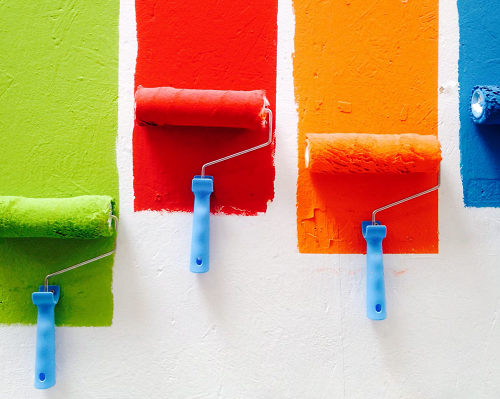
If you’re a regular reader, you will be familiar with masonry paint, its various uses and how to choose a complementary colour for the exterior of your home. However, if all this is new to you, a quick scan of our previous article should bring you up to speed!
Now, it’s time to focus on how to apply masonry paint to the exterior of your home. Following the correct method here will not only ensure that the finished results live up to your expectations – it will also help to weatherproof the surfaces and retain their like-new looks for even longer!
Masonry paint is used to protect and enhance the appearance of masonry surfaces such as brick, stone, and concrete. It is available in a variety of colours and finishes, so you can choose the right one for your project. In this blog post, we will teach you how to professionally apply the masonry paint. We will cover everything from surface preparation to final touch-ups. Let’s get started!
What You’ll Need
You’ll need to gather some supplies before you begin painting. Masonry paint, an extendable roller brush, and a ladder are all necessary. You should also have drop cloths on hand to protect any surfaces that you don’t want painted. Once you have your supplies, follow these steps to apply the paint like a pro:
Choose the Correct Attire
Professionals always take the necessary precautions to avoid ruining their clothes while they work. When painting your home’s exterior, it’s important to wear clothing that you don’t mind getting paint on. Old clothes that you can throw away after are ideal.
Check the Weather
Before you begin painting the exterior of your home, it is important to check the weather forecast. You will want to make sure that the temperature is not too hot or too cold, as this can affect the paint job. If it is too hot, the paint may dry too quickly and crack. If it is too cold, the paint will take longer to dry and may not adhere properly to the surface.
One important factor to consider before painting the exterior of your home is the weather forecast. If there is a chance of rain, it’s best to wait until the weather clears up before starting your project. This is because paint takes longer to dry in humid or wet conditions, which can cause problems with the finished product.
Do a Patch Test
Before you begin painting your home’s exterior, it’s important to do a patch test. This will help you determine if the paint is compatible with the surface of your home and if it will adhere properly. To do a patch test, simply apply a small amount of paint to an inconspicuous area of your home and let it dry. Once it’s dry, observe the area for any signs of peeling or flaking. If everything looks good, you can proceed with painting your home’s exterior.
Always Read the Label
One of the most important things to do when painting the exterior of your home is to read the manufacturer’s instructions carefully. This will ensure that you are using the right products and following the proper application techniques.
Paint Exterior Walls with an Extendable Roller
For exterior wall paint an extendable roller is the best equipment to paint your exterior walls https://www.paintmaster.co.uk/top-tips-for-painting-your-garden-gate/ because it allows you to reach high areas without the use of a ladder. It also provides even coverage and can be used with a variety of different paint types.
You’ll want to start by setting up a ladder and placing it against the wall you’ll be painting. Then, you’ll want to take your extendable roller and dip it into the paint bucket. Once the roller is coated, you can begin painting the wall from the top down. Be sure to apply even pressure as you paint so that the paint is applied evenly. You’ll want to continue this process until the entire wall is painted. Once you’re finished, you can remove the ladder and admire your work!
Two Coats Are Better Than One
One important factor to consider when painting the exterior of your home is how many coats of paint to apply. While it may be tempting to just apply one coat and be done with it, this will not provide optimal longevity or protection for your home. It is best to apply two coats of masonry paint, allowing the first coat to completely dry before applying the second. This will ensure that your home is well-protected from the elements and will look its best for years to come.
Get Ready to Transform Your Home
Thanks for reading! We hope you found this article helpful. If you’re planning to do any exterior painting this spring, we recommend bookmarking our blog or getting in touch with us. If you have any questions, please get in touch on 01663 733633. You can also reach us by emailing sales@paintmaster.co.uk
Until next time, happy painting!
The Paintmaster Team
Further Reading: Essential Renovation Projects to Improve Your Home
FAQ's
Can I paint over old masonry paint?
After old flaking paint has been removed, ensure surfaces are clean and dry. Grease or oil on the surface will bleed through the new paint, interfering with the longevity of the paint and causing it to discolour. Apply a fungicidal wash, to clean the surfaces before applying paint.
Do I need an undercoat for masonry paint?
You should be sure to first put down a coat of Paintmaster stabilising primer on your masonry. These primers are usually oil based. Your primer is going to serve as a protective coat as well as an additional binding agent for your masonry paint. Once you’ve let your primer dry, you can start with your masonry paint
Does masonry paint the same as concrete paint?
Contrary to popular belief, a standard masonry paint is not suitable to be applied to a concrete patio. This is down to several reasons: Masonry paint is designed for vertical concrete & brick walls. Masonry paint cannot withstand standing water, which an outdoor concrete patio must endure.
What is Masonry paint?
Masonry paints are highly durable weather-resistant exterior paints formulated for lasting colour and finish. They are formulated to be suitable for all surfaces, including brick, render, concrete, and previously painted exteriors. Decent masonry paint can be used anywhere. All our masonry paint is sourced from trusted, reputable, and time-tested paint professionals that cater to domestic and
What is the difference between masonry paint and regular paint?
Generally, masonry paint is used to paint the exterior of your property, whereas emulsion tends to be more for internal use. The main reasons for this are that emulsion is at all weather resistant. If exposed externally, emulsion paint will not last.
What surfaces can you use masonry paint on?
Examples of masonry surfaces that you can paint would be concrete walls, brick, stucco, plastics, and softwood. However, you should not use masonry paint on floors as it will not last, or on ferrous metals as it does not contain rust inhibiting pigments.
What surfaces does Masonry paint work best on?
Masonry paint is primed for use on walls outside, but you might want masonry paint if you’re painting any of the following surfaces: Wood Metal (fencing) Plastics outside Flat stone (interior and exterior) If there is a surface you want to paint, but you’re not sure what you need, visit our Specialist Paint section.
